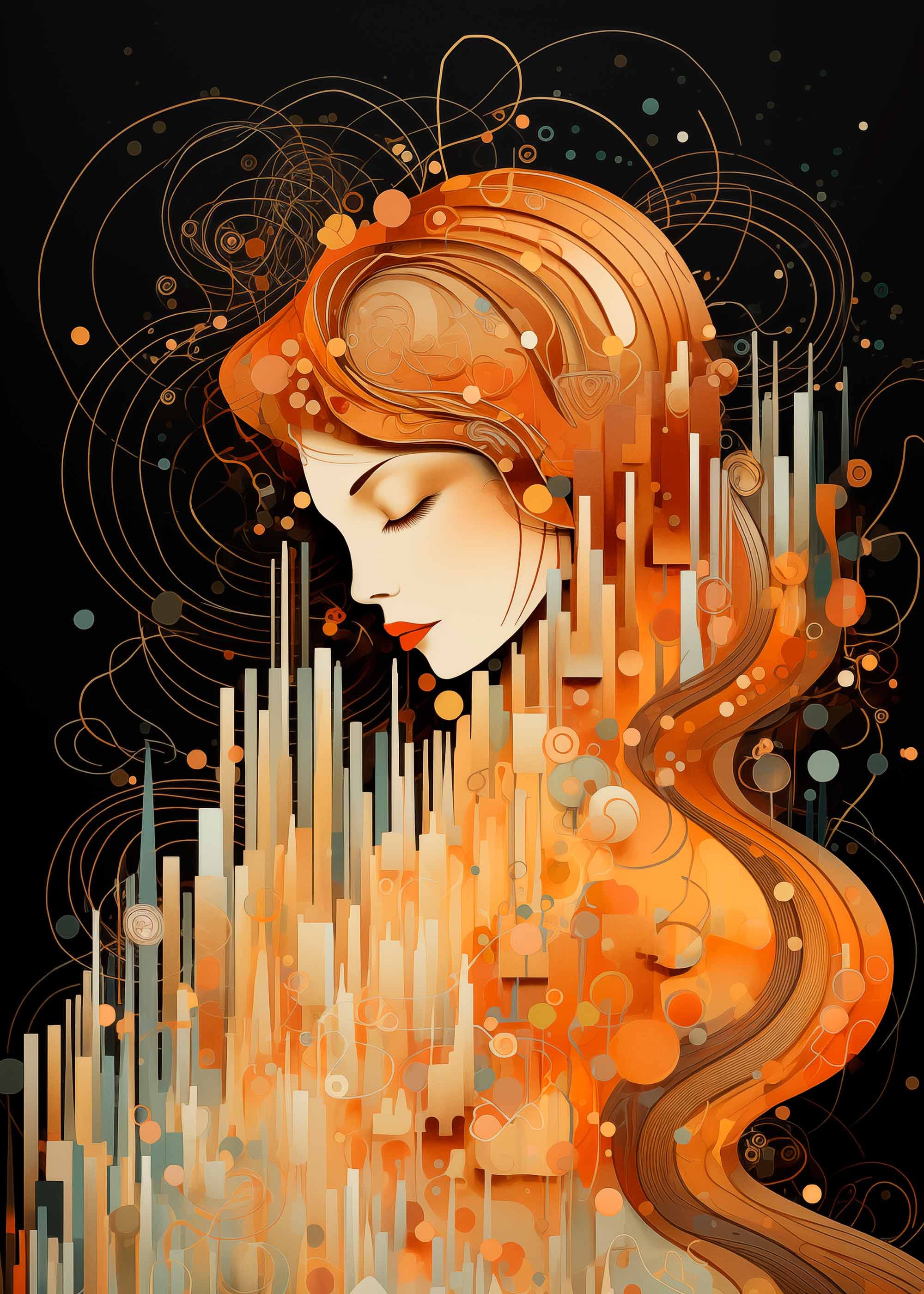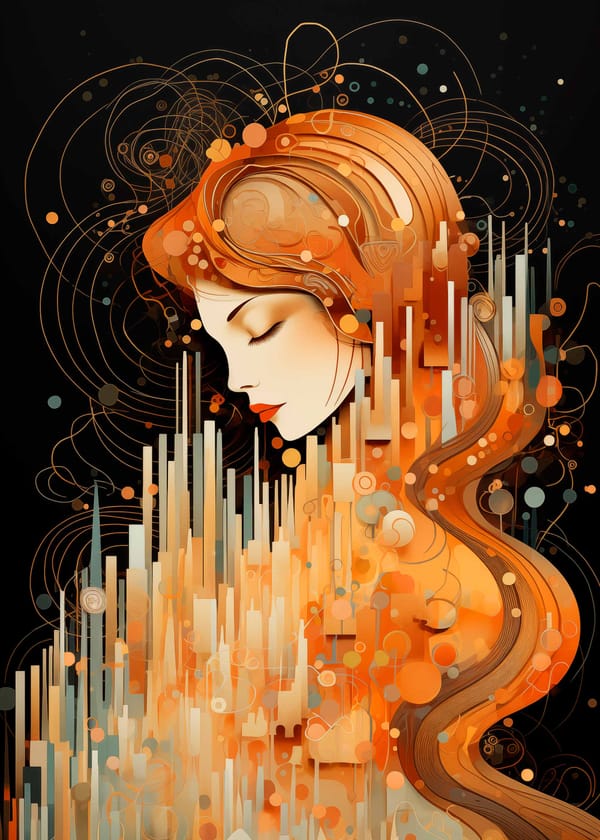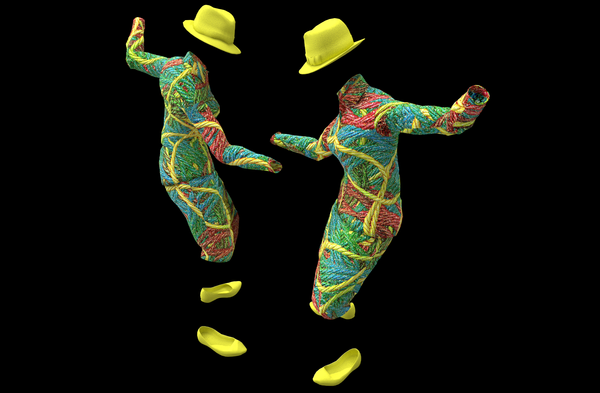The artwork "Data Visualization VIII" captivates viewers with its stunning blend of human emotion and abstract data representation. At first glance, it presents a portrait of a woman with her eyes gently closed, suggesting introspection or perhaps tranquility. The figure is rendered in warm tones of orange, ochre, and cream, giving a sense of warmth and vitality. Flowing from her hair and face are abstract geometric shapes and swirling lines that resemble the rising skyscrapers of a cityscape or intricate circuits from modern technology. This unique interplay between the organic form of a human face and the rigid geometric shapes evokes a juxtaposition between the natural and the technological—a common theme in contemporary art that reflects our increasingly data-driven society.
Human Emotions and Data Representation
How the hair dissolves into abstract shapes suggests that the woman's thoughts, memories, or emotions are represented visually as data. This transformation hints at the increasing role of technology in translating the intangible aspects of human experience into quantifiable elements. The artwork can be seen as an exploration of how human emotions are increasingly intertwined with data, with the curves and circular shapes suggesting fluidity and connection. The linear elements, reminiscent of bar charts or city skyscrapers, may symbolize structure, progress, or even the confines of technology on human expression.
The color palette, dominated by warm hues, suggests a sense of warmth, life, and vitality. The orange and gold tones can evoke optimism and energy, possibly indicating a positive take on merging humanity and technology. This warmth contrasts with the potentially cold, impersonal nature of data and technology, which in this context is made to feel almost organic, flowing, and alive. This visual warmth conveys that data, often seen as sterile and unemotional, can also hold beauty and meaning, especially when it reflects human experiences.
Movement, Complexity, and Interconnectedness
The swirling lines around the woman's head evoke a sense of movement and dynamism, suggesting the constant flow of information in our modern lives. They resemble pathways, neural networks, or even the currents of thought. Abstract circles and lines could represent the complexity and interconnectedness of data in the digital age. It evokes the idea of constantly processing information, much like how the human brain works, drawing a parallel between natural cognition and artificial processing.
Technology and Human Consciousness
"Data Visualization VIII" can be interpreted as a meditation on how technology has become integral to human consciousness. The abstract geometric forms merging with the woman’s portrait suggest that our identities are now partly shaped by the data we produce and consume. Her serene expression could imply acceptance, perhaps even peace, in this coexistence with technology. It could be suggested that rather than resisting the integration of data and technology into our personal lives, there is beauty to be found in embracing it.
The detailed layering of geometric shapes creates a visual depth that invites viewers to look closer to find patterns within the apparent randomness. This layering effect also mirrors how data accumulates in layers, each piece adding to a more comprehensive whole. Similarly, human experiences are layered and multifaceted, and this artwork beautifully represents that interplay between the deeply personal and the abstractly quantifiable.

Data Visualization VIII © Nicholas V. K.
Abstract portrait of a woman with flowing hair blending into an intricate pattern of warm-hued geometric shapes.
Data as an Extension of Human Perception
This piece also considers data an extension of human perception. The geometric forms could represent how we interpret the world, with each bar or circle symbolizing a different piece of information or sensory input. The artwork suggests that data is not just an external construct but an intrinsic part of navigating our environment and understanding our experiences. The fusion of the human figure with data elements might symbolize that, in the digital age, our perceptions are increasingly mediated by data-driven insights, algorithms, and visualizations.
Moreover, the skyscraper-like forms give a sense of an evolving city, hinting at progress, growth, and the collective nature of data. Just as cities are built from the combined effort of countless individuals, data visualizations are built from the contributions of many. The woman's presence in this "cityscape" could represent the human element within the otherwise impersonal world of data—a reminder that behind every data point is a human story, an emotion, or an experience.
Timeless Exploration of Humanity and Data
The artwork's title, "Data Visualization VIII," suggests that this piece is part of a series, potentially exploring different facets of the relationship between humanity and data. The use of Roman numerals adds a timeless quality, implying that the theme of visualizing data and its connection to human experience is an ongoing exploration, not limited to the present but part of a broader continuum. It invites viewers to think about how data visualization, often seen in a purely practical context, can also be a form of art reflecting the intricacies of human existence.
Blending Styles: Art Nouveau and Modernity
The piece's abstract aesthetic is reminiscent of Art Nouveau, with its flowing lines and organic forms, yet it is undeniably modern in its subject matter. This blending of styles could symbolize how the past and future coexist in our current moment, where traditional human experiences and emotions are now being reinterpreted through the lens of modern technology. The intricate details and the smooth, almost seamless integration of human and abstract forms create a harmonious balance, suggesting a hopeful perspective on the union of humanity and technology.
Identity in the Digital Age
In another interpretation, the artwork may also be commenting on identity in the digital age. The woman's features are softly defined, almost blending into the data-driven elements around her, which could symbolize how individual identities are becoming increasingly fluid and influenced by digital footprints. The serene expression might be interpreted as a reflection of how people find comfort in the familiarity of technology or perhaps how they lose themselves within the vast amounts of information they interact with daily.
Emotional Depth Through Light and Shadow
The careful composition of the piece, with its interplay of light and shadow, adds emotional depth. The light tones around the woman's face draw the viewer's attention to her calm expression, while the darker background emphasizes the bright, vibrant data elements, creating a striking contrast. This light might represent clarity amidst complexity—suggesting that an underlying order or beauty can be discerned even within the overwhelming flood of data.

Embracing Data and Humanity
"Data Visualization VIII" ultimately reflects on the coexistence of human nature and technology. It invites viewers to consider how data, often thought of as purely analytical or scientific, intersects with human life's emotional and subjective aspects. By portraying data as beautiful, organic, and intimately connected with a human figure, the artist challenges viewers to rethink their perceptions of technology and its role in shaping our identities and experiences.
The artwork speaks to the increasingly blurred lines between the organic and the synthetic, between human intuition and machine logic. It suggests that data is a tool for understanding the world and part of our emotional and psychological landscape. The woman's peaceful demeanor might imply a reconciliation with this reality—a message that embracing data and technology does not have to come at humanity's expense but can enhance and illuminate it in new and unexpected ways.
In conclusion, "Data Visualization VIII" is a rich, multi-layered artwork that blends abstract geometric forms and a human figure to explore the relationship between data, technology, and human emotion. Its warm color palette, intricate detailing, and evocative imagery offer a hopeful perspective on integrating data into our daily lives. It suggests that there is beauty in the ways data can represent and even enhance the human experience. It invites viewers to find harmony in the digital and organic convergence. The piece is a testament to the idea that art and data are not mutually exclusive but can be combined to create something that speaks to both the mind and the heart.






